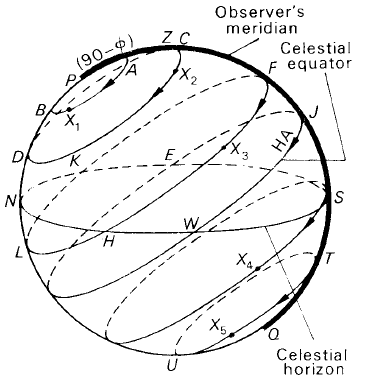
The measurement of latitude and declination
 المؤلف:
A. Roy, D. Clarke
المؤلف:
A. Roy, D. Clarke
 المصدر:
Astronomy - Principles and Practice 4th ed
المصدر:
Astronomy - Principles and Practice 4th ed
 الجزء والصفحة:
p 65
الجزء والصفحة:
p 65
 24-7-2020
24-7-2020
 2394
2394
The measurement of latitude and declination
Let us suppose an observer in latitude ∅ N observes a circumpolar star of declination δ, for example star X2 in figure 1.

Figure 1. Circumpolar stars.
Using a meridian circle or transit instrument , the zenith distances ZC and ZD of the star at upper and lower culmination are measured. Now
PC = PZ + ZC
i.e.
90 − δ = 90 − ∅ + ZC.
Hence,
∅ − δ = ZC. (1)
Also,
PD = ZD − ZP
or
90 − δ = ZD − 90 + ∅.
Hence,
∅ + δ = 180 − ZD. (2)
In equations (1) and (2) we have two equations in the two unknown quantities φ and δ. In principle, therefore, we can solve to obtain values of ∅ and δ.
In practice, a number of circumpolar stars are observed. Each star gives a pair of equations but only one extra unknown, namely the star’s declination. Thus, with six stars, twelve equations in seven unknowns given by the latitude and the six declinations have to be solved. This is done by means of a mathematical procedure such as the method of least squares.
 الاكثر قراءة في مواضيع عامة في علم الفلك
الاكثر قراءة في مواضيع عامة في علم الفلك
 اخر الاخبار
اخر الاخبار
اخبار العتبة العباسية المقدسة


